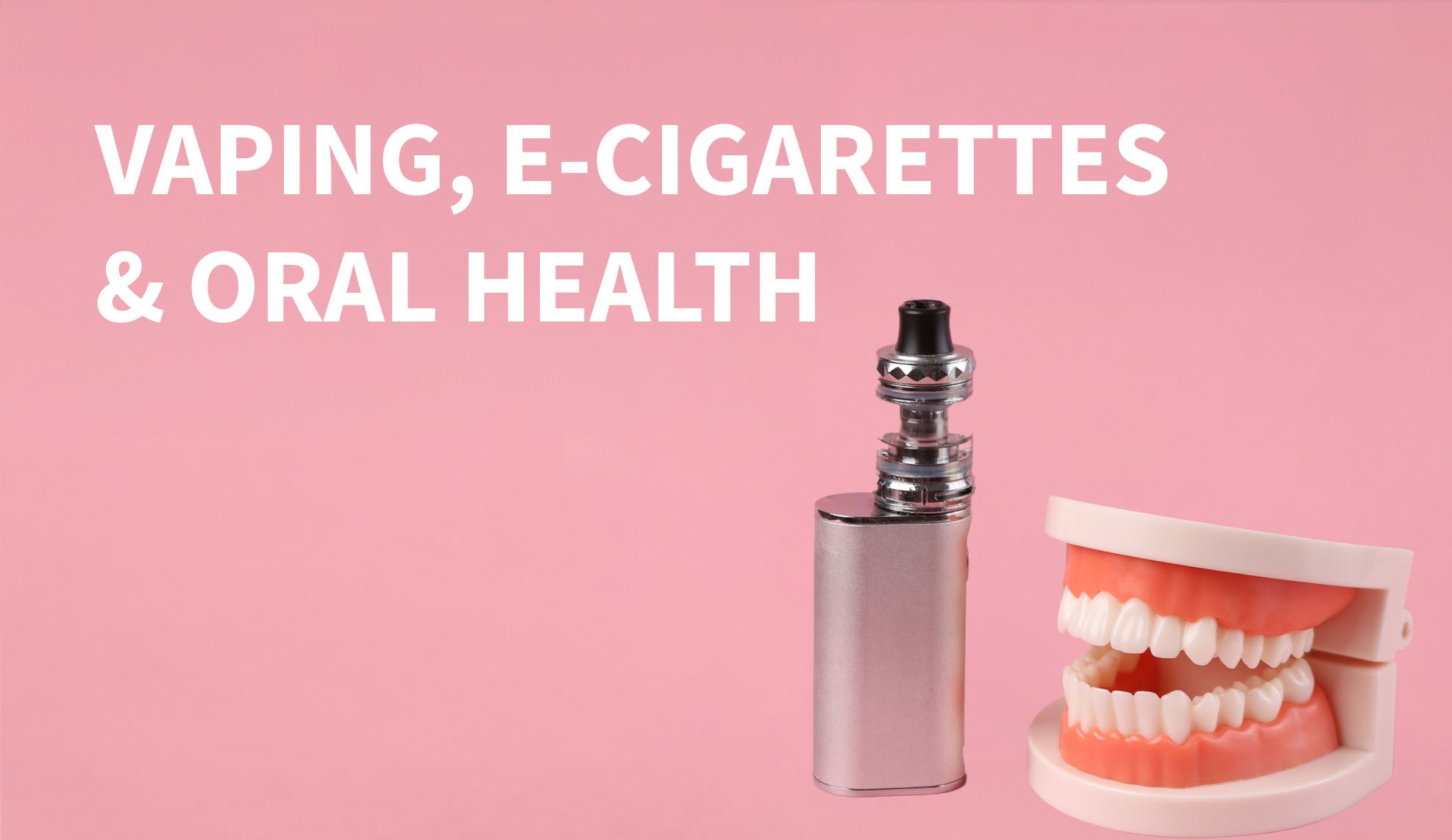Blog by Daniel Lewis and ShaLyse Walker with Dr. Paula Palo
We’ve known for years the harmful effects traditional cigarettes and smoking have on oral, dental, and systemic health—carrying not only the risk for addiction, but also an increased risk for a variety of oral cancers, including tongue, mouth, and throat cancer, as well smoking-induced lung cancer. According to the U.S. Centers for Disease Control, smoking in general increases a person’s cancer risk for almost anywhere in the body, including liver, stomach, cervix, bladder, and colon cancers, and 30% of cancer deaths worldwide can be attributed directly to smoking.
But with the availability of what are marketed as “safer alternatives” with vapes and e-cigarettes—are smokers really safer from the negative health consequences of traditional cigarettes, and if so, how much safer are they? Is it better to quit altogether?
We talked to Dr. Paula Palo, dentist and periodontist, to discuss the long and short-term benefits of switching to vaping/e-cigarettes, as well as the risks—especially when it comes to oral health.
What are Vaping and E-cigarette’s Effects on the Teeth in the Short Term?
Despite being marketed as the safer alternative, Dr. Paula Palo says, “E-cigs produce some toxic compounds shared with cigarettes.” She adds, “E-cigs work by aerosolizing a liquid that contains nicotine, propylene glycol, and glycerol [in addition to commonly added flavoring chemicals], which are then inhaled by the user, exposing the mouth and its oral microbial community [to their harmful effects].”
In fact, Dr. Palo says, “Professors at Tufts University found1 that these compounds are often sweetened to enhance the vaping/e-cigarette experience—thus coating the teeth in a sugary, sticky film that promotes bacteria growth.”
The author of the study conducted by Tufts, Dr. Irusa,1 compared vaping and smoking e-cigarettes to “going to sleep after sucking on a lollipop.”
And while studies on the potential risks of vaping and using e-cigs are scarce and the data is limited, some research is showing possible links to increased caries occurrence and periodontal disease.
Dr. Palo remarks, “Numerous case reports2,3 demonstrate the presence of oral mucosal, tongue, or ulcerative lesions in patients who use e-cigarettes. [Additionally], several cases of maxillofacial trauma are readily attributable to explosive e-cigarette device failures, including intraoral burns and alveolar fractures. While these traumatic injuries are notable, such explosions are presumably avoidable with quality manufacturing standards.”
A number of other studies4 that were not explicitly designed to assess oral health have identified dry mouth and throat irritation as common symptoms experienced by vape and e-cigarette users—both contributors to increased risk of caries and tooth decay. Furthermore, Dr. Palo says, “In a systematic review of eleven studies4,5 that assessed e-cigarettes as potential smoking cessation aids, cough or mouth/throat irritation was the most commonly reported group of adverse events, occurring in up to 39% of participants. This corroborates a U.S. national telephone survey in which cough (40%) and dry or irritated mouth or throat (31%) were the most common of six recorded symptoms for adult e-cigarette users.”
In the U.S., children under the age of 18 also reported increased dental problems among both conventional cigarette users as well as e-cigarette users, compared with non-smokers. Among adults, that same study found that daily nicotine vape pen and e-cigarette users were more likely to report removing a tooth due to gum disease or decay than non-nicotine users. In South Korea, risk for periodontal disease in e-cigarette, vape users, and conventional cigarette users is approximately double, compared with non-users.
Dr. Palo adds, “Several studies6–11 [also] analyzed the impact of vaping [and e-cigarettes] on periodontal parameters and found increased plaque index levels and marginal bone loss compared with non-smokers.”
Thus, users should proceed with caution if they are under the impression that switching from conventional cigarettes to vaping or e-cigarettes will eliminate health risks. Besides the many metals present in the aerosol, potential for blast injuries, and cancer, vaping has been linked to numerous cases of severe pulmonary disease throughout the U.S.
What Are Vaping and E-Cigarettes’ Long-Term Effects?
When it comes to vaping and the smoking e-cigarettes’ long-term health effects, there aren’t currently enough long-term studies to accurately assess the risks—particularly because its hypothesized risks are chronic conditions that develop long-term/over the course of life, while e-cigarette and vape use have only gained substantial popularity within the past five to ten years. Additionally, many adult e-cigarette and nicotine vape users are former conventional cigarette smokers, making it difficult to separate the negative health effects attributed to conventional smoking vs e-cigarettes and vapes.
However, Dr. Palo relates that “the systemic health effects of e-cigarettes are still under investigation and the subject of debate. It is widely accepted that e-cigarettes emit fewer toxicants than smoking tobacco, although several studies and reviews have identified possible long-term cardiovascular and respiratory harm occur because of the practice.” She adds, “Particular concerns have also been raised about the potential harm [e-cigarettes and vaping] can have on a developing adolescent brain, and requires more investigation, according to the U.S. Surgeon General.”
However, there is clear evidence on the long-term, harmful effects of nicotine use and nicotine addiction, especially in young people. For teens, chronic nicotine use can alter brain development, leading to cognitive and behavior problems down the road. Even vaping without nicotine exposes the user to chemicals that are released in the heating process of the device, such as aluminum, copper, and lead. Outside of the United States, many countries also impose no regulations on the safe manufacture of e-cigarettes and vaping devices, making it even more dangerous for those that choose to use them in those parts of the world.
A Habit on the Rise
Even more concerning than not knowing much about the long-term effects of vaping and using e-cigarettes, is that their use, especially among young people, is on the rise. A study12 conducted by the Canadian Tobacco, Alcohol and Drugs Survey found that 23% students between 7–12th grades have tried a vaping or e-cigarette product at least once, with 10% using them in the past 30 days at the time of the survey. Also, 53% of students in the study reported that it would be “fairly easy” or “very easy” to get a vaping or e-cigarette device if they wanted one.
What We Know
While official long-term effects aren’t yet known, short-term evidence suggests that vaping and using e-cigarettes negatively impacts oral health. While they do show some improvement to the effects of smoking conventional cigarettes, it’s certainly not a cure-all solution with no risks and no health consequences. Most importantly, we know oral health is systemic health, and that good health starts in the mouth. To learn more about how you can keep your oral health in top shape, get a smile you’re proud of, and even whiten the stains caused by years of nicotine and/or tobacco use, click here.
References
1. Irusa KF, Finkelman M, Magnuson B, Donovan T, Eisen SE. A coparison of caries risk between patients who use vapes or electronic cigarettes and those who do not: A cross-sectional study. J Am Dent Assoc. 2022;153(12):1179-1183. Doi:10.1016/j.adaj.2022.09.013
2. Holliday R, Chaffee BW, Jakubovics NS, Kist R, Preshaw PM. Electronic Cigarettes and Oral Health. J Dent Res. 2021;100(9):906-913. doi:10.1177/00220345211002116
3. Yang I, Sandeep S, Rodriguez J. The oral health impact of eletcronic cigarette use: a systematic review [published correction appears in Crit Rev Toxicol. 2020 Feb;50(2):188. doi:10.1080/10408444.2020.1713726
4. Liu X, Lu W, Liao S, et al. Efficiency and adverse events of electronic cigarettes: A systematic review and meta-analysis (PRISMA-compliant article). Medicine (Baltimore). 2018;97(19):e0324. Doi:10.1097/MD.0000000000010324
5. King JL, Reboussin BA, Wiseman KD, et al. Adverse symptoms users attribute to e-cigarettes: Results from a national survey of US adults. Drug Alcohol Depend. 2019;196:9-13 doi:10.1016/jdrugalcdep.2018.11.030
6. ArRejaie AS, Al-Aali KA, Alrabiah M, et al. Proinflammatory cytokine levels and peri-implant parameters among cigarettes smokers, individuals vaping electronic cigarettes, and non-smokers. J Periodontol. 2019;90(4):367-374. Doi:10.1002/JPER.18-0045
7. Javed F, Abduljabbar T, Vohra F, Malmstrom H, Rahman I, Romanos GE. Comparison of Periodontal Parameters and Self-Perceived Oral Symptoms Among Cigarettes Smokers, Individuals Vaping Electronic Cigarettes, and Never-Smokers. J Periodontol. 2017;88(10):1059-1065. doi:10.1902/jop.2017.170197
8. Mokeem SA, Alasqah MN, Michelogiannakis D, Al-Kheraif AA, Romanos GE, Javed F. Clinical and radiografic periodontal status and whole salivary cotinine, IL-1b and IL-6 levels in cigarette-and waterpipe-smokers and E-cig users. Environ Toxicol Pharmacol. 2018;61:38-43. doi:10.1016/j.etap.2018.05.016
9. BinShabaib M, ALHarthi SS, Akram Z, et al. Clinical periodontal status and gingival crevicular fluid cytokine profile among cigarette-smokers, electronic-cigarette users and never-smokers. Arch Oral Biol. 2019;102:212-217. doi:10.1016/j.archoralbio.2019.05.001
10. ALHArthi SS, BinShabaib M, Akram Z, Rahman I, Romanos GE, Javed F. Impact of cigarette smoking and vaping on the outcome of full-mouth ultrasonic scaloing among patients with gingival inflammation: a prospective study. Clin Oral Investig. 2019;23(6):2751-2758. doi:10.1007/s00784-018-2725-2
11. Ghazali AF, Ismail AF, Faisal GG, Halil MHM, Daud A. Oral Health of Smokers and E-Cigarette Users ACase-Control Study. Journal of International Dental and Medical Research. 2018;11(2):428-432.
12. CSTADS was developed to provide timely, reliable and continual monitoring of tobacco, alcohol and drug use in school-aged youth. CSTADS provides essential input to the development of policies and programs. The next survey is expected to be carried out during the 2023-24








